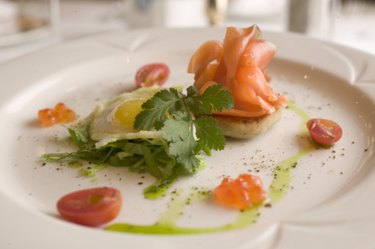Things You'll Need
Cheesecloth or plastic wrap
1 salmon fillet, skin on, approximately 3 lbs.
Fish tweezers or clean, stainless-steel, needle-nose pliers
1/2-lb. coarse salt, not iodized table salt
1/4-lb.sugar
1 tbsp. granulated onion powder
Additional herbs, spices or seasonings to taste, or as directed in other recipes
Mixing bowl
Large sealable container, or large plastic bag
Vinyl kitchen gloves (optional)

Brining is a term used for the process of lightly salting meats, fish or poultry to impart flavor and improve texture. The technique may be used for cooking, smoking or drying foods, with only slight variations in the procedure. Salt is the primary ingredient, although sugar or another sweetener is generally used to mellow the flavor. Salmon is an excellent fish to experiment with because its rich and mellow taste complements many flavorings and is forgiving of errors.
Step 1
Lay out a large piece of cheesecloth or plastic wrap on your work surface. If you wish to use kitchen gloves, put them on before handling the salmon.
Video of the Day
Step 2
Place the salmon on the cheesecloth, skin side down. Feel for pin bones at the head end of the fillet. These 27 short, stubby bones are arranged in a row between the fillet's center line and the top edge. Remove them with fish tweezers, or a sanitized pair of stainless steel, needle-nose pliers.
Step 3
Mix the salt, sugar and flavoring ingredients thoroughly in a bowl. Spread them over the surface of the salmon, taking care that the entire surface is covered. The flesh of the tail is thinner, so reduce the amount of salt mixture at the tail end.
Step 4
Fold the cheesecloth or plastic wrap to hold the salt mixture in place on the salmon fillet. Place the fillet in a flat container with a lid, or in a long plastic bag. Refrigerate for 12 to 24 hours, depending on the desired strength of flavor.
Step 5
Remove the fillet from refrigeration, and carefully rinse off the salt mixture with cool water. Blot the surface dry. Return the fillet to the refrigerator, uncovered, for at least 12 hours. This dries the surface and allows a thin skin to form, called a "pellicle," which retains the smoke flavor.
Step 6
Smoke as directed, using either the hot-smoking or cold-smoking technique.
Tip
Salmon may be either hot-smoked or cold-smoked.
Hot-smoked salmon is cooked in the smoking process and has the same texture as any other piece of cooked salmon. Various flavor combinations are used, such as lemon and cracked pepper, Southwestern, pastrami-type seasonings or hot, sweet, barbecue-type seasonings.
Cold-smoked salmon remains uncooked in the smoking process, relying on the salt and sugar "cure" mixture to make it food-safe. It retains a soft and silky texture and usually is sliced very thin for bagels or canapes. Seasonings such as dill and gin, or shredded beets and horseradish, are traditional in Scandinavia, but modern chefs feel free to experiment with combinations such as lime, cilantro, cumin and tequila.
Warning
Although the brining and smoking process makes smoked salmon relatively safe, refrigerate until it is served in the interest of food safety. Avoid leaving smoked salmon on the table for extended periods. In large receptions or family get-togethers, serve smoked salmon in small batches, and remove any portions that remain uneaten after two hours.
Video of the Day